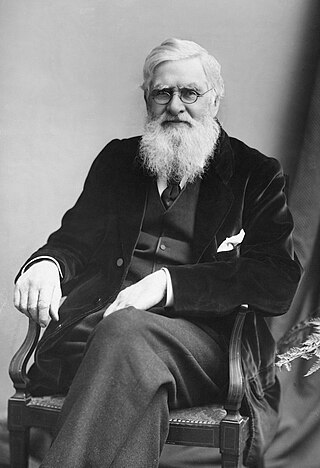
Alfred Russel Wallace was an English naturalist, explorer, geographer, anthropologist, biologist and illustrator. He independently conceived the theory of evolution through natural selection; his 1858 paper on the subject was published that year alongside extracts from Charles Darwin's earlier writings on the topic. It spurred Darwin to set aside the "big species book" he was drafting and quickly write an abstract of it, which was published in 1859 as On the Origin of Species.

Henry Walter Bates was an English naturalist and explorer who gave the first scientific account of mimicry in animals. He was most famous for his expedition to the rainforests of the Amazon with Alfred Russel Wallace, starting in 1848. Wallace returned in 1852, but lost his collection on the return voyage when his ship caught fire. When Bates arrived home in 1859 after a full eleven years, he had sent back over 14,712 species of which 8,000 were new to science. Bates wrote up his findings in his best-known work, The Naturalist on the River Amazons.
The Linnean Society of London is a learned society dedicated to the study and dissemination of information concerning natural history, evolution, and taxonomy. It possesses several important biological specimen, manuscript and literature collections, and publishes academic journals and books on plant and animal biology. The society also awards a number of prestigious medals and prizes.
"On the Tendency of Species to form Varieties; and on the Perpetuation of Varieties and Species by Natural Means of Selection" is the title of a journal article, comprising and resulting from the joint presentation of two scientific papers to the Linnean Society of London on 1 July 1858: On The Tendency of Varieties to Depart Indefinitely from the Original Type by Alfred Russel Wallace and an Extract from an unpublished Work on Species from Charles Darwin's Essay of 1844. The article also includes an Abstract of a Letter from Darwin to Asa Gray, and an introductory letter by Joseph Dalton Hooker and Charles Lyell. The article was the first announcement of the Darwin–Wallace theory of evolution by natural selection; and appeared in print on 20 August 1858. The presentation of the papers spurred Darwin to write a condensed "abstract" of his "big book", Natural Selection. This was published in November 1859 as On the Origin of Species.
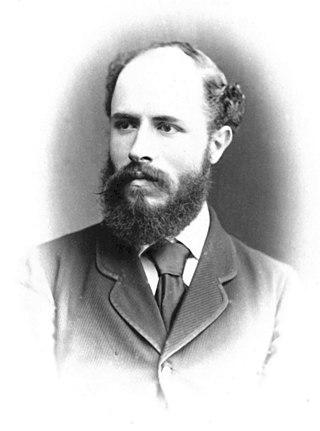
James Wood-Mason was an English zoologist. He was the director of the Indian Museum at Calcutta, after John Anderson. He collected marine animals and lepidoptera, but is best known for his work on two other groups of insects, phasmids and mantises.

Octavius Pickard-Cambridge FRS was an English clergyman and zoologist. He was a keen arachnologist who described and named more than 900 species of spider.
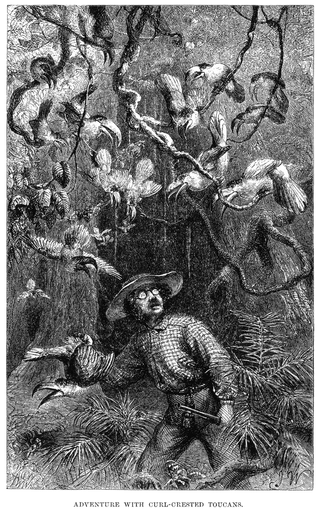
The Naturalist on the River Amazons, subtitled A Record of the Adventures, Habits of Animals, Sketches of Brazilian and Indian Life, and Aspects of Nature under the Equator, during Eleven Years of Travel, is an 1863 book by the British naturalist Henry Walter Bates about his expedition to the Amazon basin. Bates and his friend Alfred Russel Wallace set out to obtain new species and new evidence for evolution by natural selection, as well as exotic specimens to sell. He explored thousands of miles of the Amazon and its tributaries, and collected over 14,000 species, of which 8,000 were new to science. His observations of the coloration of butterflies led him to discover Batesian mimicry.

Thomas Hornsey Bell FRS FLS was an English zoologist, dental surgeon and writer, born in Poole, Dorset, England.

Broadstone is a suburb of Poole in Dorset, England. It is located 3 miles (4.8 km) from Hamworthy railway station and 7 miles (11 km) from Bournemouth International Airport. The ward had a population of 10,303 at the 2011 Census, increasing from 10,256 at the 2001 Census.

John Joseph Bennett was a British physician and botanist. He was the younger brother of the zoologist Edward Turner Bennett.
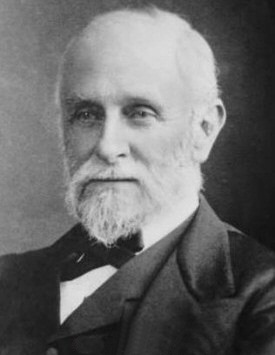
John Jenner Weir, FLS, FZS was an English amateur entomologist, ornithologist and British civil servant. He is best known today for being one of the naturalists who corresponded with and provided important data to both Charles Darwin and Alfred Russel Wallace.

The Malay Archipelago is a book by the British naturalist Alfred Russel Wallace which chronicles his scientific exploration, during the eight-year period 1854 to 1862, of the southern portion of the Malay Archipelago including Malaysia, Singapore, the islands of Indonesia, then known as the Dutch East Indies, and the island of New Guinea. It was published in two volumes in 1869, delayed by Wallace's ill health and the work needed to describe the many specimens he brought home. The book went through ten editions in the nineteenth century; it has been reprinted many times since, and has been translated into at least twelve languages.

The Darwin–Wallace Medal is a medal awarded by the Linnean Society of London for "major advances in evolutionary biology". Historically, the medals have been awarded every 50 years, beginning in 1908. That year marked 50 years after the joint presentation by Charles Darwin and Alfred Russel Wallace of two scientific papers—On the Tendency of Species to form Varieties; and on the Perpetuation of Varieties and Species by Natural Means of Selection—to the Linnean Society of London on 1 July 1858. Fittingly, Wallace was one of the first recipients of the medal, in his case it was, exceptionally, in gold, rather than the silver version presented in the six other initial awards. However, in 2008 the Linnean Society announced that due to the continuing importance of evolutionary research, the medal will be awarded on an annual basis beginning in 2010.
James Mallet is an evolutionary zoologist specialising in entomology.
James Motley was a Yorkshireman closely associated with South Wales and Borneo.
John van Wyhe, is a British historian of science, with a focus on Charles Darwin and Alfred Russel Wallace, at the National University of Singapore. He holds various academic and research positions, ranging from founder and director of The Complete Works of Charles Darwin Online, Scientific Associate, The Natural History Museum (London), a Fellow of the Linnean Society and a Member of the British Society for the History of Science. He has given more than 50 public lectures on Darwin in more than a dozen countries. He lectures and broadcasts on Darwin, evolution, science and religion and the history of science around the world. He also wrote The Darwin Experience, a biographical book about Charles Darwin.
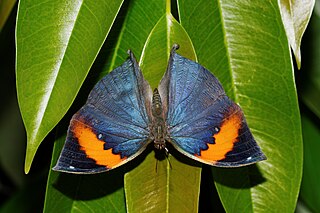
Kallima paralekta, the Indian leafwing or Malayan leafwing, is a species of brush-footed butterfly of the genus Kallima. Despite its common names, it is not found in India or Malaysia, but is endemic to Java and Sumatra of Indonesia. Like other members of its genus, it is remarkable for its strong resemblance to a dead leaf when its wings are folded. It was one of the species encountered by the British naturalist Alfred Russel Wallace in his travels in maritime Southeast Asia. It is mentioned in his famous 19th-century work The Malay Archipelago as one of the best examples of protective camouflage achieved through natural selection.

Mary Elizabeth Barber was a pioneering British-born amateur scientist of the nineteenth century. Without formal education, she made a name for herself in botany, ornithology and entomology. She was also an accomplished poet and painter, and illustrated her scientific contributions that were published by learned societies such as the Royal Entomological Society in London, the Royal Botanical Gardens in Kew, and the Linnean Society of London.

T. W. Wood was an English zoological illustrator responsible for the accurate drawings in major nineteenth century works of natural history including Darwin's The Descent of Man and Wallace's The Malay Archipelago. He studied the courtship display behaviour of pheasants, observing them closely and publishing the first description of the double-banded argus pheasant. He illustrated many books, often of birds but also of moths and mammals.

Anthony Smith is a British sculptor who works in bronze. He is known for his wildlife sculptures as well as his depictions of well-known figures, including Charles Darwin, Ian Fleming, and Alfred Russel Wallace. He has been awarded major public commissions including the design of a new £2 coin for the Royal Mint, the first new statue for London's Natural History Museum in more than eighty years, and a life-sized statue of Charles Darwin for Christ's College, Cambridge. In addition, he is a wildlife photographer.
















